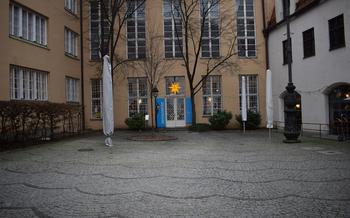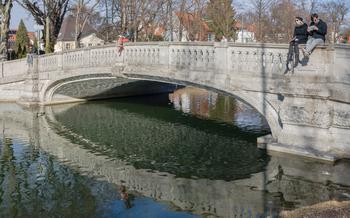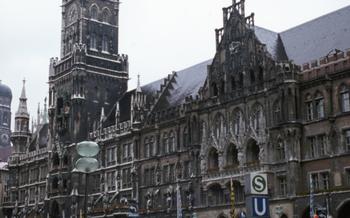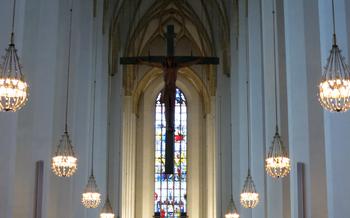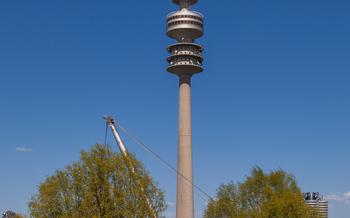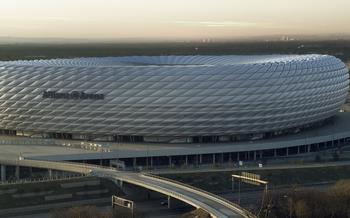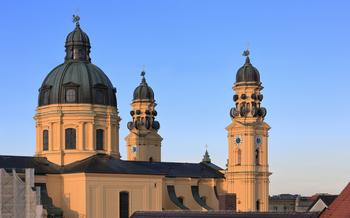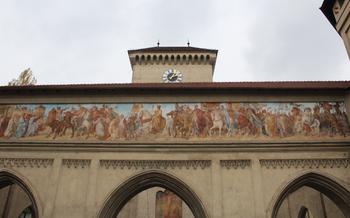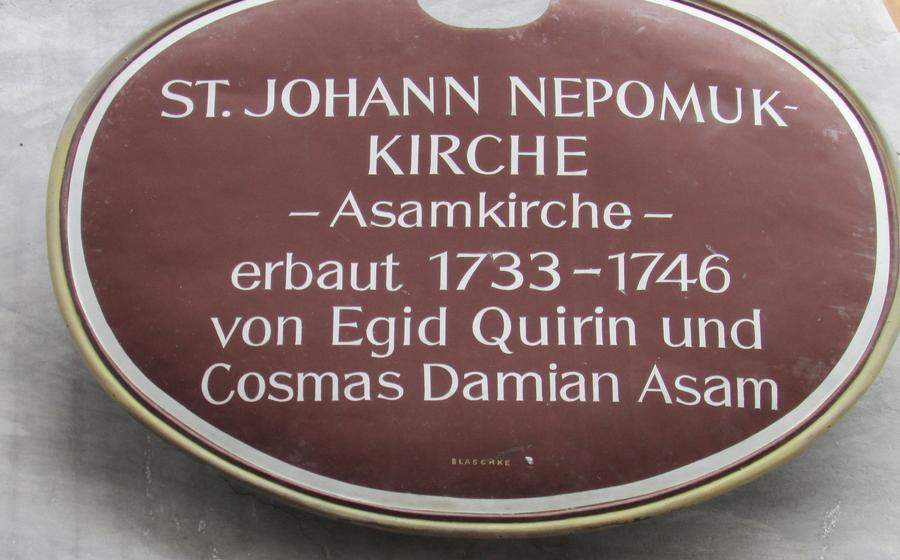
Asamkirche (St. Johann Nepomuk Church)
- A Rococo Masterpiece
- Location and Getting There
- Visiting Hours and Admission
- Exploring the Interior
- The High Altar
- The Frescoes:
- The Pulpit
- The Organ
- Crypt and Catacombs
- Audio Guides and Guided Tours
- Nearby Attractions
- Local Cuisine and Restaurants
- Shopping and Souvenirs
- Events and Festivals
- Insider Tip: Discover the Secret Courtyard Garden
A Rococo Masterpiece
In the heart of Munich's vibrant city center, nestled between bustling streets and historic landmarks, stands the Asamkirche, a dazzling testament to the grandeur of the Rococo era. Built in the early 18th century by the Asam brothers, Cosmas Damian and Egid Quirin, this magnificent church is a testament to their genius and an embodiment of the extravagant artistic style that swept across Europe during that period.
The Asamkirche, also known as the Church of St. Johann Nepomuk, is not just a religious edifice but a true masterpiece of Baroque architecture. Its opulent façade, adorned with intricate carvings and graceful curves, hints at the splendor that awaits within. The brothers, both renowned artists and architects, poured their hearts and souls into every detail of the church's design, creating a harmonious blend of architectural prowess and artistic brilliance.
One of the most striking features of the Asamkirche is its stunning interior, a symphony of vibrant colors, intricate stucco work, and breathtaking frescoes. The brothers' mastery of the Rococo style is evident in every corner of the church, from the soaring ceiling to the ornate pulpit. Their innovative use of light and shadow, combined with the vibrant hues of the frescoes, creates a sense of awe and wonder that leaves visitors spellbound.
As legend has it, the Asam brothers faced opposition from the authorities during the construction of the church. Undeterred, they built the church on their property, ensuring that the façade faced their own residence so they could admire their creation from their windows. This act of defiance only adds to the mystique and charm of the Asamkirche, a true testament to the power of artistic vision and determination.
Location and Getting There
The Asamkirche, a stunning masterpiece of Baroque architecture, is situated in the heart of Munich's vibrant city center. Its exact address is Sendlinger Straße 32, placing it within easy reach of numerous landmarks and attractions. To fully immerse yourself in the city's rich history and culture, the Asamkirche is a must-see destination.
Reaching the church is a breeze, thanks to Munich's efficient public transportation system. The closest U-Bahn (metro) station is Sendlinger Tor, just a short walk away. Alternatively, several tram and bus lines stop nearby, providing convenient connections from various parts of the city.
For those arriving by car, limited parking is available in the surrounding streets, but be prepared to pay parking fees during weekdays. However, the most rewarding way to experience the Asamkirche is on foot. Munich's compact city center allows you to stroll from one attraction to another, soaking in the city's charm along the way. From Marienplatz, the central square, it's an easy 15-minute walk to the church, taking you past other architectural gems and bustling shopping streets.
Visiting Hours and Admission
The Asamkirche welcomes visitors from all over the world, offering regular opening hours for self-guided exploration and organized guided tours.
Exploring the Interior
As you step inside the Asamkirche, your gaze is immediately drawn to the intricate and awe-inspiring interior. The church's layout follows a traditional Latin cross design, with a central nave flanked by two aisles. The high altar stands at the far end of the nave, while the pulpit and organ are positioned on either side.
The church's interior is a testament to the artistic prowess of the Asam brothers. The walls and ceiling are adorned with stunning frescoes that depict biblical stories and scenes from the lives of saints. The high altar is an elaborate masterpiece, featuring a painting of the Assumption of Mary by Cosmas Damian Asam. The pulpit, carved from white marble, showcases the exquisite craftsmanship of Egid Quirin Asam.
The Asam brothers used a variety of artistic techniques to create the church's interior. The frescoes are painted in the Rococo style, characterized by their use of soft colors, curved lines, and intricate details. The high altar and pulpit are adorned with sculptures, gilding, and precious stones. The overall effect is one of grandeur and opulence.
One of the most striking features of the church's interior is the trompe-l'œil ceiling fresco. Painted by Cosmas Damian Asam, the fresco creates the illusion of a vast open sky, complete with floating angels and billowing clouds. The effect is so convincing that visitors often mistake it for an actual skylight.
The High Altar
The high altar of the Asamkirche is an awe-inspiring masterpiece that commands attention with its intricate design and profound symbolism. Crafted from gleaming marble and adorned with delicate stuccowork, it stands as the centerpiece of the church's interior. The focal point of the altar is the central painting, a breathtaking depiction of the martyrdom of St. John of Nepomuk. The work, attributed to the renowned artist Cosmas Damian Asam, portrays the saint's unwavering faith as he courageously faces his execution. The vibrant colors and expressive brushstrokes bring the scene to life, evoking a sense of both reverence and awe.
Beneath the painting, a golden tabernacle houses the consecrated Eucharist, a testament to the church's dedication to the Holy Sacrament. The altar's design incorporates numerous symbolic elements, including cherubs, doves, and angels, each representing divine virtues and the heavenly realm. One striking detail is the presence of two larger-than-life statues flanking the tabernacle, depicting St. Peter and St. Paul, the patron saints of the Catholic Church. Their imposing presence symbolizes the foundation of the church upon the apostles' teachings.
An anecdote associated with the altar tells of a visit by the renowned composer Wolfgang Amadeus Mozart. Deeply moved by the altar's beauty, Mozart is said to have exclaimed, "If I had known of this church, I would have written a mass specifically for it." This anecdote underscores the altar's profound impact on visitors, inspiring both artistic and spiritual contemplation.
The Frescoes:
The ceiling of the Asamkirche is adorned with a breathtaking fresco cycle painted by the renowned Bavarian artist, Johann Baptist Zimmermann. This cycle, depicting scenes from the life of St. John of Nepomuk, is regarded as one of the finest examples of Baroque ceiling painting in Germany.
Zimmermann's frescoes showcase a masterful use of perspective and illusion, creating a sense of depth and grandeur that draws the viewer's gaze upwards. Biblical narratives and allegorical figures intertwine harmoniously, narrating the life of the saint and extolling his virtues.
The vibrant colors and dynamic compositions of the frescoes imbue the church interior with a sense of celestial glory. Each scene is meticulously detailed, capturing the emotions and expressions of the characters with remarkable realism.
As you admire these exquisite works of art, take a moment to reflect on the dedication and artistry that went into their creation. The frescoes not only serve as a testament to Zimmermann's genius but also encapsulate the essence of the Baroque era, where art was used to inspire and uplift the human spirit.
The Pulpit
Intricately carved and adorned with intricate details, the pulpit of the Asamkirche stands as a testament to the artistic mastery of the Asam brothers. Crafted from the finest wood, its elegant form draws the eye upward, inviting visitors to contemplate the divine messages imparted from this sacred platform.
The pulpit's central panel depicts a vivid representation of the Good Shepherd, a symbol of Christ's loving care for his flock. The compassionate gaze of the shepherd and the intricate details of the surrounding foliage create a sense of serenity and peace, reminding visitors of the divine guidance that guides their lives.
The pulpit's intricate carvings extend beyond the central panel, adorning its base and canopy with a symphony of angels, flowers, and other celestial motifs. These delicate embellishments serve to enhance the pulpit's overall grandeur, transforming it into a true masterpiece of Baroque artistry.
A particularly captivating anecdote surrounds a controversial sermon delivered from this very pulpit. In the early 19th century, a visiting preacher ignited a storm of debate with his fiery condemnation of the prevailing social norms. His words, echoing through the vaulted ceilings, sparked a heated discussion among the congregation, leaving an indelible mark on the history of the Asamkirche.
Today, the pulpit remains a central feature of the church, serving as a poignant reminder of the eloquence and power of religious oratory. Its intricate carvings and rich symbolism invite visitors to reflect on the teachings of Christ and the enduring legacy of the Asam brothers.
The Organ
The Asamkirche boasts a magnificent organ that stands as a testament to the church's rich musical heritage. Built in the early 18th century, the organ is a masterpiece of craftsmanship, featuring intricate carvings and delicate ornamentation. Its impressive size and commanding presence add to the awe-inspiring atmosphere of the church's interior.
Over the years, the Asamkirche organ has been played by renowned organists, each leaving their mark on its legacy. The organ's unique acoustics and tonal qualities have made it a favorite among musicians and music lovers alike. Visitors to the church are often treated to impromptu concerts or recitals, showcasing the organ's versatility and power.
In 1733, a young Wolfgang Amadeus Mozart, then a child prodigy, visited the Asamkirche and was captivated by the organ's enchanting sounds. He spent hours exploring its intricacies and experimenting with its various stops. The experience is said to have left a lasting impression on the young composer, inspiring him to pursue his musical journey.
Today, the Asamkirche organ continues to play a vital role in the church's liturgical services and musical events. Its majestic sound reverberates through the grand interior, creating a truly immersive and spiritual experience for all who gather within its walls.
Crypt and Catacombs
Beneath the Asamkirche lies a hidden world of history and intrigue – the crypt and catacombs. These subterranean spaces offer a glimpse into the church's past and provide a unique perspective on the lives of those who have worshipped here. The crypt, located directly beneath the church, houses the remains of the Asam brothers and other notable figures associated with the church. Visitors can explore the dimly lit corridors, lined with ornate sarcophagi and memorials, and learn about the individuals who played a significant role in the church's construction and legacy.
The catacombs, an extension of the crypt, are a labyrinthine network of tunnels and chambers that were once used as a burial ground. Here, visitors can witness the final resting places of ordinary citizens, whose lives and stories are forever intertwined with the history of the Asamkirche. While access to the catacombs is typically restricted, guided tours may occasionally be offered, providing visitors with a rare opportunity to explore these hidden depths.
Audio Guides and Guided Tours
Enhance your visit to the Asamkirche by opting for an audio guide or a guided tour. Audio guides are available in multiple languages, offering insightful commentary on the church's history, architecture, and artwork. They allow you to explore at your own pace and focus on the aspects that interest you the most.
Guided tours, led by knowledgeable experts, provide a more in-depth experience. These tours delve into the symbolism and stories behind the church's design, offering a deeper understanding of its significance. They also allow you to ask questions and gain insights from the guide's expertise.
Whether you prefer the self-guided approach of an audio tour or the interactive experience of a guided tour, both options enrich your visit to the Asamkirche, ensuring that you leave with a newfound appreciation for this architectural masterpiece.
In my experience, I opted for a guided tour, and I was thoroughly impressed by the guide's knowledge and passion for the church. He brought the Asamkirche's history and stories to life, making the visit even more memorable.
Nearby Attractions
Just a few steps away from the Asamkirche, you'll find yourself in the heart of Munich's historic city center. Take a leisurely stroll along Sendlinger Straße, a vibrant pedestrianized street lined with charming boutiques, cafes, and restaurants. Admire the colorful facades of the buildings and soak in the lively atmosphere.
A short walk from the Asamkirche, you'll reach Marienplatz, the central square of Munich. Here, you can marvel at the iconic Neues Rathaus (New Town Hall) with its intricate Gothic architecture and the famous Glockenspiel, a mechanical clock that chimes and performs a captivating show every day at 11 am and 12 pm.
For art enthusiasts, a visit to the Alte Pinakothek, one of the oldest and most renowned art museums in the world, is a must. Its collection boasts masterpieces from the 14th to the 18th centuries, including works by Albrecht Dürer, Rembrandt, and Rubens.
If you're looking for a unique shopping experience, head to Viktualienmarkt, a bustling market hall filled with colorful stalls selling fresh produce, traditional Bavarian delicacies, and handmade crafts. Indulge in a hearty breakfast or lunch at one of the market's many food stalls, savoring the flavors of local specialties like Weißwurst and Obatzda.
Local Cuisine and Restaurants
Indulge in the culinary delights of Bavaria, just steps away from the Asamkirche. From traditional taverns serving hearty local fare to modern eateries showcasing contemporary twists on classic dishes, the neighborhood offers a diverse dining scene. For an authentic Bavarian experience, try Augustiner-Keller, a traditional tavern renowned for its crispy Schweinshaxe (roasted pork knuckle) and frothy Hofbräu beer. Don't miss the Weisswurst, a traditional Munich sausage, usually paired with a sweet mustard and a pretzel. If you prefer a more modern take on Bavarian cuisine, visit St. Oberholz, a stylish restaurant known for its creative dishes and vibrant atmosphere. Their Maultaschen (filled pasta pockets) with a wild mushroom ragout are a must-try. Pair your meal with a local craft beer or a glass of wine from the region's renowned vineyards. For a quick and delicious bite, head to Viktualienmarkt, a bustling food market just a short walk away. Here, you'll find everything from fresh produce and artisanal cheeses to gourmet sandwiches and exotic spices. Savor the flavors of Bavaria and make your visit to Munich a culinary adventure to remember.
Shopping and Souvenirs
After your spiritual and artistic immersion in the Asamkirche, you might want to take a piece of Munich's charm home with you. The area surrounding the church offers a delightful array of shops and boutiques catering to souvenir seekers. From traditional Bavarian handicrafts to quirky contemporary designs, there's something for every taste and budget.
One of my favorite shops is just a stone's throw away from the church, on Sendlinger Straße. It's a treasure trove of handcrafted wooden cuckoo clocks, intricately painted ceramic beer steins, and whimsical nutcrackers. The friendly owner is always happy to share stories about the artisans who create these unique pieces.
If you're looking for more modern souvenirs, head to the nearby Viktualienmarkt, a vibrant food market that also boasts a variety of stalls selling souvenirs. Here, you'll find everything from colorful Oktoberfest-themed magnets to stylish jewelry inspired by Bavarian traditions.
To truly immerse yourself in the local culture, be sure to sample some of the delicious Bavarian delicacies available at the market. From freshly baked pretzels to artisanal cheeses and sausages, there's a culinary adventure waiting for you at every corner. And who knows, you might just stumble upon a hidden gem that becomes a cherished reminder of your time in Munich.
Events and Festivals
The Asamkirche is not just a place of worship but also a venue for various cultural and religious events throughout the year. One can attend regular concerts featuring classical music, organ recitals, and sacred choral performances. The church is also known for its annual festivals, such as the Asamtage in September, which celebrates the life and work of the Asam brothers. Highlights of the festival include special masses, concerts, guided tours, and exhibitions. During the Christmas season, the church hosts festive concerts and events, creating a magical ambiance within its ornate interior. Whether you're a music lover, a history buff, or simply seeking a spiritual experience, attending an event at the Asamkirche is a unique opportunity to immerse yourself in the vibrant cultural heritage of Munich.
Insider Tip: Discover the Secret Courtyard Garden
Stroll just a few steps behind the Asamkirche, and you'll stumble upon a hidden gem – a serene courtyard garden known as the Asamhof. This tranquil oasis offers a delightful contrast to the ornate grandeur of the church. Take a moment to relax on a bench amidst the lush greenery, surrounded by historical buildings and the gentle sound of a fountain. It's the perfect spot to escape the hustle and bustle of the city and find a moment of peace and tranquility.

